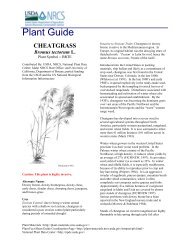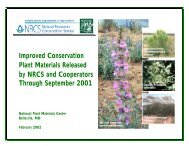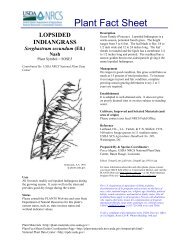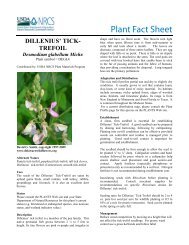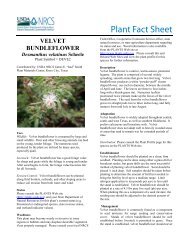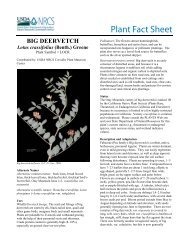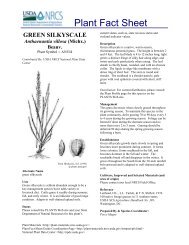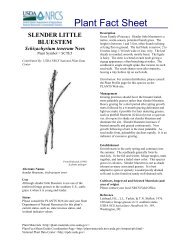black cherry - USDA Plants Database - US Department of Agriculture
black cherry - USDA Plants Database - US Department of Agriculture
black cherry - USDA Plants Database - US Department of Agriculture
Create successful ePaper yourself
Turn your PDF publications into a flip-book with our unique Google optimized e-Paper software.
BLACK CHERRY<br />
Prunus serotina Ehrh. var.<br />
virens (Woot. & Standl.)<br />
McVaugh<br />
Plant Symbol = PRSEV<br />
Contributed by: <strong><strong>US</strong>DA</strong> NRCS National Plant Data<br />
Center & the Biota <strong>of</strong> North America Program<br />
James L. Reveal<br />
Botany Dept., NMNH, Smithsonian Institution<br />
@ PLANTS<br />
Alternate Names<br />
Wild <strong>black</strong> <strong>cherry</strong>, mountain <strong>black</strong> <strong>cherry</strong>, rum<br />
<strong>cherry</strong><br />
Uses<br />
Black <strong>cherry</strong> wood is a rich reddish-brown color and<br />
is strong, hard, and close-grained – one <strong>of</strong> the most<br />
valued cabinet and furniture woods in North<br />
America. It is also used for paneling, interior trim,<br />
veneers, handles, crafts, toys, and scientific<br />
instruments. Black <strong>cherry</strong> is used for reclamation <strong>of</strong><br />
surface mine spoil.<br />
The leaves, twigs, bark, and seeds produce a<br />
cyanogenic glycoside. Most livestock poisoning<br />
apparently comes from eating wilted leaves, which<br />
contain more <strong>of</strong> the toxin than fresh leaves, but<br />
white-tailed deer browse seedlings and saplings<br />
without harm. The inner bark, where the glycoside is<br />
concentrated, was used historically in the<br />
Appalachians as a cough remedy, tonic, and sedative.<br />
The glycoside derivatives act by quelling spasms in<br />
the smooth muscles lining bronchioles. Very large<br />
amounts <strong>of</strong> <strong>black</strong> <strong>cherry</strong> pose the theoretical risk <strong>of</strong><br />
causing cyanide poisoning.<br />
Plant Guide<br />
The fruit has been used to flavor rum and brandy<br />
(“<strong>cherry</strong> bounce”). Pitted fruits are edible and are<br />
eaten raw and used in wine and jelly. Black <strong>cherry</strong><br />
fruits are important food for numerous species <strong>of</strong><br />
passerine birds, game birds, and mammals, including<br />
the red fox, <strong>black</strong> bear, raccoon, opossum, squirrels,<br />
and rabbits.<br />
Status<br />
Please consult the PLANTS Web site and your State<br />
<strong>Department</strong> <strong>of</strong> Natural Resources for this plant’s<br />
current status, such as, state noxious status and<br />
wetland indicator values.<br />
Description<br />
General: Rose Family (Rosaceae). Native trees to 38<br />
m tall; bark <strong>of</strong> larger trunks fissured and scaly, but<br />
thin. Leaves are alternate, simple, ovate to oblonglanceolate,<br />
5-15 cm long, 2.5-5 cm wide, with finely<br />
toothed margins, glabrous or commonly with reddish<br />
hairs along the midrib beneath, near the base.<br />
Inflorescence is an oblong-cylindric raceme 10-15<br />
cm long at the end <strong>of</strong> leafy twigs <strong>of</strong> the season, with<br />
numerous flowers; calyx tube <strong>of</strong> short lobes, petals 5,<br />
white. Fruits are berry-like, about 8-10 mm in<br />
diameter, obovoid, <strong>black</strong> when ripe; seed a single,<br />
<strong>black</strong>, ovoid stone 6-8 mm long. The common name<br />
is from the <strong>black</strong> color <strong>of</strong> the ripe fruits.<br />
Variation within the species: The species has a<br />
number <strong>of</strong> geographic variants:<br />
Var. eximia (Small) Little - Edwards Plateau <strong>of</strong><br />
central TX<br />
Var. rufula (Woot. & Standl.) McVaugh - TX,<br />
NM, AZ<br />
Var. serotina - widespread in the eastern <strong>US</strong><br />
Var. virens (Woot. & Standl.) McVaugh - TX,<br />
NM, AZ<br />
Var. salicifolia Koehne - Mexico and Guatemala<br />
Var. serotina may reach 38 meters tall in the eastern<br />
<strong>US</strong>, but southwestern <strong>US</strong> varieties typically are<br />
smaller; southwestern <strong>black</strong> <strong>cherry</strong> (var. rufula)<br />
seldom grows taller than 9 m, and escarpment <strong>black</strong><br />
<strong>cherry</strong> (var. exima) no taller than 15 meters. The<br />
leaves <strong>of</strong> var. serotina are thin compared to those <strong>of</strong><br />
the other varieties. Domesticants and wild<br />
populations <strong>of</strong> P. serotina in Mexico and Central<br />
America, called "capulin" (var. salicifolia), have<br />
larger (2 cm) fruits, apparently through selection by<br />
native peoples. <strong>Plants</strong> previously recognized as P.<br />
serotina var. alabamensis (Mohr) Little have been<br />
Plant Materials <br />
Plant Fact Sheet/Guide Coordination Page <br />
National Plant Data Center
taxonomically returned to species rank, as P.<br />
alabamensis Mohr.<br />
Distribution<br />
Widespread in eastern North America, from Nova<br />
Scotia, New Brunswick, and Quebec, Canada,<br />
Minnesota and North Dakota, southward to Florida<br />
and east Texas, with outlying populations in central<br />
Texas, west Texas, New Mexico, and Arizona, and<br />
south in Mexico to Guatemala. Known to be highly<br />
invasive in forests <strong>of</strong> Holland and other countries <strong>of</strong><br />
Western Europe; also naturalized in northern South<br />
America. For current distribution, please consult the<br />
Plant Pr<strong>of</strong>ile page for this species on the PLANTS<br />
Web site.<br />
Adaptation<br />
Black <strong>cherry</strong> is a shade-intolerant species that<br />
primarily occurs in successional vegetation or in<br />
forest openings as well as in old fields and along<br />
fencerows. It usually occurs as scattered individuals<br />
in various types <strong>of</strong> mesic woods and second-growth<br />
hardwood forests; at elevations <strong>of</strong> 0-1520 meters.<br />
Black <strong>cherry</strong> in the southwestern <strong>US</strong> is confined to<br />
canyons, valleys, and rich bottomlands. Flowering:<br />
May-July (March-April in the Southwest); fruiting:<br />
June-October.<br />
Establishment<br />
Seeds may be produced on trees as young as 10<br />
years, but maximum production in natural stands<br />
occurs on trees 30-100 years old. Some seed is<br />
produced yearly, with good crops produced at 1-5year<br />
intervals. High proportions <strong>of</strong> the seeds are<br />
viable. Because <strong>of</strong> long-distance seed dispersal by<br />
birds and mammals, seedlings are <strong>of</strong>ten abundant in<br />
sites with no or few reproductive <strong>black</strong> <strong>cherry</strong> trees.<br />
Seeds that pass through the digestive tracts <strong>of</strong><br />
passerine birds also have higher germination rates<br />
than undigested seeds.<br />
Seeds from one crop germinate over a period <strong>of</strong> 3<br />
years –– this delayed germination allows large<br />
numbers <strong>of</strong> seeds to be banked in the forest floor.<br />
After cold stratification, seeds germinate in loose soil<br />
and forest litter; germination is higher in litter than in<br />
mineral soil. Seedlings typically grow to a height <strong>of</strong><br />
5-10 cm within 30 days after germination.<br />
Black <strong>cherry</strong> also reproduces by stump sprouts<br />
following cutting or fire, and sprouting frequency<br />
remains high for trees up to about 60 years <strong>of</strong> age.<br />
Black <strong>cherry</strong> rarely occurs in the canopy <strong>of</strong> late<br />
successional deciduous forests but buried seeds are<br />
present and an abundance <strong>of</strong> small seedlings is<br />
common in the understory. These grow slowly in<br />
dense shade, sometimes reaching 15 cm in height in<br />
3-4 years, but any canopy opening will release this<br />
bank <strong>of</strong> suppressed plants, which grow rapidly to<br />
overtop shade-tolerant associates. Black <strong>cherry</strong><br />
saplings in the understory may repeatedly die back to<br />
the stem base and resprout and can persist for 40-60<br />
years by maintaining a small above-ground size until<br />
released. Because <strong>of</strong> its abundant soil-stored seeds<br />
and sprouting ability, <strong>black</strong> <strong>cherry</strong> may dominate<br />
secondary succession following logging, fire, or<br />
wind-throw. Trees have been reported to grow to<br />
more than 250 years, although mortality increases<br />
rapidly after 80-100 years.<br />
Management<br />
Black <strong>cherry</strong> is sometimes grown in even-aged<br />
management –– clearcutting or shelterwood cuts are<br />
used, depending on the availability <strong>of</strong> soil-stored<br />
seed. Where deer populations are high, successful<br />
regeneration may require that larger seedlings be so<br />
abundant that deer cannot eat them all. Because it is<br />
shallow-rooted and has a tendency to overtop its<br />
associates in mixed stands, <strong>black</strong> <strong>cherry</strong> is<br />
susceptible to wind throw. Best results in<br />
establishing <strong>black</strong> <strong>cherry</strong> on reclamation or<br />
rehabilitation sites are by planting 1-year or older<br />
nursery grown seedlings. Direct seeding has<br />
generally been unsuccessful.<br />
The thin bark <strong>of</strong> <strong>black</strong> <strong>cherry</strong> makes it highly<br />
susceptible to girdling and it is usually killed or topkilled<br />
by fires <strong>of</strong> moderate severity. As fire severity<br />
increases, the percentage <strong>of</strong> tree-sized individuals<br />
killed also increases. When aboveground portions<br />
are killed by fire, <strong>black</strong> <strong>cherry</strong> sprouts prolifically<br />
from the root crown or stump. This vegetative<br />
reproduction, however, depletes carbohydrate<br />
reserves and leaves plants in a weakened condition.<br />
Quickly repeated fires would probably kill any<br />
seedlings and saplings that survived the first fire by<br />
resprouting.<br />
Pests and Potential Problems<br />
The eastern tent caterpillar and the <strong>cherry</strong> scallop<br />
shell moth defoliate <strong>black</strong> <strong>cherry</strong> and can cause<br />
growth loss and mortality. The fungal disease “<strong>black</strong><br />
knot” is common on <strong>black</strong> <strong>cherry</strong> – it causes<br />
elongated, rough, <strong>black</strong> swellings on the twigs,<br />
branches, and trunk.<br />
Cultivars, Improved and Selected Materials (and<br />
area <strong>of</strong> origin)<br />
These plant materials are readily available from<br />
commercial sources. Contact your local Natural<br />
Resources Conservation Service (formerly Soil
Conservation Service) <strong>of</strong>fice for more information.<br />
Look in the phone book under ”United States<br />
Government.” The Natural Resources Conservation<br />
Service will be listed under the subheading<br />
“<strong>Department</strong> <strong>of</strong> <strong>Agriculture</strong>.”<br />
References<br />
Allard, H.A. 1944. Second year sprouts <strong>of</strong> <strong>black</strong><br />
<strong>cherry</strong>, Prunus serotina, fruiting. Castanea 9:117.<br />
Carter, K.K. 1980. Geographic variation in <strong>black</strong><br />
<strong>cherry</strong> (Prunus serotina Ehrh.). Ph.D. diss., West<br />
Virginia Univ., Morgantown, West Virginia.<br />
Downey, S.L., R. Karle, A.F. Iezzoni, J.F. Hancock,<br />
& B.K. Epperson 1998. Patterns <strong>of</strong> genetic diversity<br />
within and among <strong>black</strong> <strong>cherry</strong> (Prunus serotina<br />
Ehrh.) populations from the U.S., Mexico, and<br />
Ecuador. Abstract, 1998 Annual Meeting <strong>of</strong> the Bot.<br />
Soc. Amer., Baltimore, Maryland.<br />
[http://www.ou.edu/cas/botany-micro/bsaabst/section4/abstracts/11.shtml]<br />
McVaugh, R. 1951. A revision <strong>of</strong> the North<br />
American <strong>black</strong> cherries (Prunus serotina Ehrh. and<br />
relatives). Brittonia 7:279-315.<br />
McVaugh, R. 1952. Suggested phylogeny <strong>of</strong> Prunus<br />
serotina and other wide ranging phylads in North<br />
America. Brittonia 7:317-346.<br />
Marquis, D.A. 1990. Prunus serotina Ehrh. Black<br />
Cherry. Pp. 594-604, IN: R.M. Burns and B.H.<br />
Honkala. Silvics <strong>of</strong> North America. Volume 2.<br />
Hardwoods. <strong><strong>US</strong>DA</strong> Forest Service Agric. Handbook<br />
654, Washington, D.C.<br />
<br />
Mulligan, G.A. & D.B. Munro 1981. The biology <strong>of</strong><br />
Canadian weeds, 51. Prunus virginiana L. and P.<br />
serotina Ehrh. Canad. J. Pl. Sci. 61:977-992.<br />
Uchytil, R.J. 1991. Prunus serotina. IN: W.C.<br />
Fischer (compiler). The fire effects information<br />
system [<strong>Database</strong>]. <strong><strong>US</strong>DA</strong>, Forest Service,<br />
Intermountain Research Station, Intermountain Fire<br />
Sciences Laboratory, Missoula, Montana.<br />
<br />
Prepared By<br />
Guy Nesom<br />
Formerly BONAP, North Carolina Botanical Garden,<br />
University <strong>of</strong> North Carolina, Chapel Hill, North<br />
Carolina<br />
Species Coordinator<br />
Gerald Guala<br />
<strong><strong>US</strong>DA</strong>, NRCS, National Plant Data Center, Baton<br />
Rouge, Louisiana<br />
Edited 04dec00 jsp; 13feb03 ahv; 060808 jsp<br />
For more information about this and other plants, please contact<br />
your local NRCS field <strong>of</strong>fice or Conservation District, and visit the<br />
PLANTS Web site or the Plant Materials<br />
Program Web site <br />
The U.S. <strong>Department</strong> <strong>of</strong> <strong>Agriculture</strong> (<strong><strong>US</strong>DA</strong>) prohibits<br />
discrimination in all its programs and activities on the basis <strong>of</strong><br />
race, color, national origin, sex, religion, age, disability, political<br />
beliefs, sexual orientation, and marital or family status. (Not all<br />
prohibited bases apply to all programs.) Persons with disabilities<br />
who require alternative means for communication <strong>of</strong> program<br />
information (Braille, large print, audiotape, etc.) should contact<br />
<strong><strong>US</strong>DA</strong>'s TARGET Center at 202-720-2600 (voice and TDD).<br />
To file a complaint <strong>of</strong> discrimination write <strong><strong>US</strong>DA</strong>, Director, Office<br />
<strong>of</strong> Civil Rights, Room 326-W, Whitten Building, 14th and<br />
Independence Avenue, SW, Washington, DC 20250-9410 or call<br />
202-720-5964 (voice or TDD). <strong><strong>US</strong>DA</strong> is an equal opportunity<br />
provider and employer.<br />
Read about Civil Rights at the Natural Resources Convervation<br />
Service.



